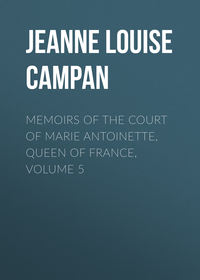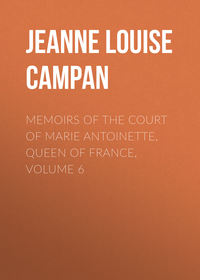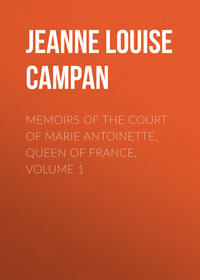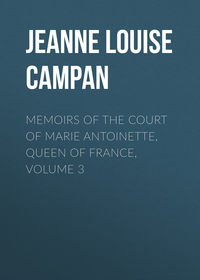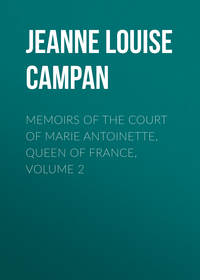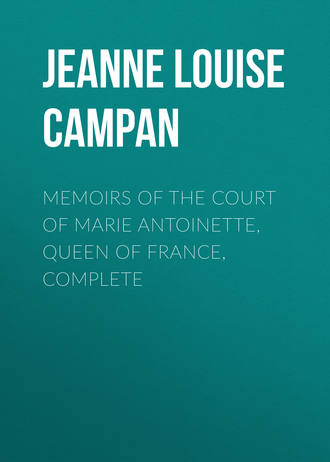 полная версия
полная версияMemoirs of the Court of Marie Antoinette, Queen of France, Complete
The next day a very ill-natured song was circulated; the stamp of the party to which it was attributable might easily be seen upon it. I remember only the following chorus:
“Little Queen, you must not beSo saucy, with your twenty years;Your ill-used courtiers soon will seeYou pass, once more, the barriers.Fal lal lal, fal lal la.”The errors of the great, or those which ill-nature chooses to impute to them, circulate in the world with the greatest rapidity, and become historical traditions, which every one delights to repeat.
More than fifteen years after this occurrence I heard some old ladies in the most retired part of Auvergne relating all the particulars of the day of public condolence for the late King, on which, as they said, the Queen had laughed in the faces of the sexagenarian duchesses and princesses who had thought it their duty to appear on the occasion.
The King and the Princes, his brothers, determined to avail themselves of the advantages held out by inoculation, as a safeguard against the illness under which their grandfather had just fallen; but the utility of this new discovery not being then generally acknowledged in France, many persons were greatly alarmed at the step; those who blamed it openly threw all the responsibility of it upon the Queen, who alone, they said, could have ventured to give such rash advice, inoculation being at this time established in the Northern Courts. The operation upon the King and his brothers, performed by Doctor Jauberthou, was fortunately quite successful.
When the convalescence of the Princes was perfectly established, the excursions to Marly became cheerful enough. Parties on horseback and in calashes were formed continually. The Queen was desirous to afford herself one very innocent gratification; she had never seen the day break; and having now no other consent than that of the King to seek, she intimated her wish to him. He agreed that she should go, at three o’clock in the morning, to the eminences of the gardens of Marly; and, unfortunately, little disposed to partake in her amusements, he himself went to bed. Foreseeing some inconveniences possible in this nocturnal party, the Queen determined on having a number of people with her; and even ordered her waiting women to accompany her. All precautions were ineffectual to prevent the effects of calumny, which thenceforward sought to diminish the general attachment that she had inspired. A few days afterwards, the most wicked libel that appeared during the earlier years of her reign was circulated in Paris. The blackest colours were employed to paint an enjoyment so harmless that there is scarcely a young woman living in the country who has not endeavoured to procure it for herself. The verses which appeared on this occasion were entitled “Sunrise.”
The Duc d’Orleans, then Duc de Chartres, was among those who accompanied the young Queen in her nocturnal ramble: he appeared very attentive to her at this epoch; but it was the only moment of his life in which there was any advance towards intimacy between the Queen and himself. The King disliked the character of the Duc de Chartres, and the Queen always excluded him from her private society. It is therefore without the slightest foundation that some writers have attributed to feelings of jealousy or wounded self-love the hatred which he displayed towards the Queen during the latter years of their existence.
It was on this first journey to Marly that Boehmer, the jeweller, appeared at Court,—a man whose stupidity and avarice afterwards fatally affected the happiness and reputation of Marie Antoinette. This person had, at great expense, collected six pear-formed diamonds of a prodigious size; they were perfectly matched and of the finest water. The earrings which they composed had, before the death of Louis XV., been destined for the Comtesse du Barry.
Boehmer; by the recommendation of several persons about the Court, came to offer these jewels to the Queen. He asked four hundred thousand francs for them. The young Princess could not withstand her wish to purchase them; and the King having just raised the Queen’s income, which, under the former reign, had been but two hundred thousand livres, to one hundred thousand crowns a year, she wished to make the purchase out of her own purse, and not burthen the royal treasury with the payment. She proposed to Boehmer to take off the two buttons which formed the tops of the clusters, as they could be replaced by two of her own diamonds. He consented, and then reduced the price of the earrings to three hundred and sixty thousand francs; the payment for which was to be made by instalments, and was discharged in the course of four or five years by the Queen’s first femme de chambre, deputed to manage the funds of her privy purse. I have omitted no details as to the manner in which the Queen first became possessed of these jewels, deeming them very needful to place in its true light the too famous circumstance of the necklace, which happened near the end of her reign.
It was also on this first journey to Marly that the Duchesse de Chartres, afterwards Duchesse d’Orleans, introduced into the Queen’s household Mademoiselle Bertin, a milliner who became celebrated at that time for the total change she effected in the dress of the French ladies.
It may be said that the mere admission of a milliner into the house of the Queen was followed by evil consequences to her Majesty. The skill of the milliner, who was received into the household, in spite of the custom which kept persons of her description out of it, afforded her the opportunity of introducing some new fashion every day. Up to this time the Queen had shown very plain taste in dress; she now began to make it a principal occupation; and she was of course imitated by other women.
All wished instantly to have the same dress as the Queen, and to wear the feathers and flowers to which her beauty, then in its brilliancy, lent an indescribable charm. The expenditure of the younger ladies was necessarily much increased; mothers and husbands murmured at it; some few giddy women contracted debts; unpleasant domestic scenes occurred; in many families coldness or quarrels arose; and the general report was,—that the Queen would be the ruin of all the French ladies.
Fashion continued its fluctuating progress; and head-dresses, with their superstructures of gauze, flowers, and feathers, became so lofty that the women could not find carriages high enough to admit them; and they were often seen either stooping, or holding their heads out of the windows. Others knelt down in order to manage these elevated objects of ridicule with less danger.
[If the use of these extravagant feathers and head-dresses had continued, say the memoirs of that period very seriously, it would have effected a revolution in architecture. It would have been found necessary to raise the doors and ceilings of the boxes at the theatre, and particularly the bodies of carriages. It was not without mortification that the King observed the Queen’s adoption of this style of dress: she was never so lovely in his eyes as when unadorned by art. One day Carlin, performing at Court as harlequin, stuck in his hat, instead of the rabbit’s tail, its prescribed ornament, a peacock’s feather of excessive length. This new appendage, which repeatedly got entangled among the scenery, gave him an opportunity for a great deal of buffoonery. There was some inclination to punish him; but it was presumed that he had not assumed the feather without authority.-NOTE BY THE EDITOR.]
Innumerable caricatures, exhibited in all directions, and some of which artfully gave the features of the Queen, attacked the extravagance of fashion, but with very little effect. It changed only, as is always the case, through the influence of inconstancy and time.
The Queen’s toilet was a masterpiece of etiquette; everything was done in a prescribed form. Both the dame d’honneur and the dame d’atours usually attended and officiated, assisted by the first femme de chambre and two ordinary women. The dame d’atours put on the petticoat, and handed the gown to the Queen. The dame d’honneur poured out the water for her hands and put on her linen. When a princess of the royal family happened to be present while the Queen was dressing, the dame d’honneur yielded to her the latter act of office, but still did not yield it directly to the Princesses of the blood; in such a case the dame d’honneur was accustomed to present the linen to the first femme de chambre, who, in her turn, handed it to the Princess of the blood. Each of these ladies observed these rules scrupulously as affecting her rights. One winter’s day it happened that the Queen, who was entirely undressed, was just going to put on her shift; I held it ready unfolded for her; the dame d’honneur came in, slipped off her gloves, and took it. A scratching was heard at the door; it was opened, and in came the Duchesse d’Orleans: her gloves were taken off, and she came forward to take the garment; but as it would have been wrong in the dame d’honneur to hand it to her she gave it to me, and I handed it to the Princess. More scratching it was Madame la Comtesse de Provence; the Duchesse d’Orleans handed her the linen. All this while the Queen kept her arms crossed upon her bosom, and appeared to feel cold; Madame observed her uncomfortable situation, and, merely laying down her handkerchief without taking off her gloves, she put on the linen, and in doing so knocked the Queen’s cap off. The Queen laughed to conceal her impatience, but not until she had muttered several times, “How disagreeable! how tiresome!”
All this etiquette, however inconvenient, was suitable to the royal dignity, which expects to find servants in all classes of persons, beginning even with the brothers and sisters of the monarch.
Speaking here of etiquette, I do not allude to majestic state, appointed for days of ceremony in all Courts. I mean those minute ceremonies that were pursued towards our Kings in their inmost privacies, in their hours of pleasure, in those of pain, and even during the most revolting of human infirmities.
These servile rules were drawn up into a kind of code; they offered to a Richelieu, a La Rochefoucauld and a Duras, in the exercise of their domestic functions, opportunities of intimacy useful to their interests; and their vanity was flattered by customs which converted the right to give a glass of water, to put on a dress, and to remove a basin, into honourable prerogatives.
Princes thus accustomed to be treated as divinities naturally ended by believing that they were of a distinct nature, of a purer essence than the rest of mankind.
This sort of etiquette, which led our Princes to be treated in private as idols, made them in public martyrs to decorum. Marie Antoinette found in the Chateau of Versailles a multitude of established customs which appeared to her insupportable.
The ladies-in-waiting, who were all obliged to be sworn, and to wear full Court dresses, were alone entitled to remain in the room, and to attend in conjunction with the dame d’honneur and the tirewoman. The Queen abolished all this formality. When her head was dressed, she curtsied to all the ladies who were in her chamber, and, followed only by her own women, went into her closet, where Mademoiselle Bertin, who could not be admitted into the chamber, used to await her. It was in this inner closet that she produced her new and numerous dresses. The Queen was also desirous of being served by the most fashionable hairdresser in Paris. Now the custom which forbade all persons in inferior offices, employed by royalty, to exert their talents for the public, was no doubt intended to cut off all communication between the privacy of princes and society at large; the latter being always extremely curious respecting the most trifling particulars relative to the private life of the former. The Queen, fearing that the taste of the hairdresser would suffer if he should discontinue the general practice of his art, ordered him to attend as usual certain ladies of the Court and of Paris; and this multiplied the opportunities of learning details respecting the household, and very often of misrepresenting them.
One of the customs most disagreeable to the Queen was that of dining every day in public. Maria Leczinska had always submitted to this wearisome practice; Marie Antoinette followed it as long as she was Dauphiness. The Dauphin dined with her, and each branch of the family had its public dinner daily. The ushers suffered all decently dressed people to enter; the sight was the delight of persons from the country. At the dinner-hour there were none to be met upon the stairs but honest folks, who, after having seen the Dauphiness take her soup, went to see the Princes eat their ‘bouilli’, and then ran themselves out of breath to behold Mesdames at their dessert.
Very ancient usage, too, required that the Queens of France should appear in public surrounded only by women; even at meal-times no persons of the other sex attended to serve at table; and although the King ate publicly with the Queen, yet he himself was served by women with everything which was presented to him directly at table. The dame d’honneur, kneeling, for her own accommodation, upon a low stool, with a napkin upon her arm, and four women in full dress, presented the plates to the King and Queen. The dame d’honneur handed them drink. This service had formerly been the right of the maids of honour. The Queen, upon her accession to the throne, abolished the usage altogether. She also freed herself from the necessity of being followed in the Palace of Versailles by two of her women in Court dresses, during those hours of the day when the ladies-in-waiting were not with her. From that time she was accompanied only by a single valet de chambre and two footmen. All the changes made by Marie Antoinette were of the same description; a disposition gradually to substitute the simple customs of Vienna for those of Versailles was more injurious to her than she could possibly have imagined.
When the King slept in the Queen’s apartment he always rose before her; the exact hour was communicated to the head femme de chambre, who entered, preceded by a servant of the bedchamber bearing a taper; she crossed the room and unbolted the door which separated the Queen’s apartment from that of the King. She there found the first valet de chambre for the quarter, and a servant of the chamber. They entered, opened the bed curtains on the King’s side, and presented him slippers generally, as well as the dressing-gown, which he put on, of gold or silver stuff. The first valet de chambre took down a short sword which was always laid within the railing on the King’s side. When the King slept with the Queen, this sword was brought upon the armchair appropriated to the King, and which was placed near the Queen’s bed, within the gilt railing which surrounded the bed. The first femme de chambre conducted the King to the door, bolted it again, and, leaving the Queen’s chamber, did not return until the hour appointed by her Majesty the evening before. At night the Queen went to bed before the King; the first femme de chambre remained seated at the foot of her bed until the arrival of his Majesty, in order, as in the morning, to see the King’s attendants out and bolt the door after them. The Queen awoke habitually at eight o’clock, and breakfasted at nine, frequently in bed, and sometimes after she had risen, at a table placed opposite her couch.
In order to describe the Queen’s private service intelligibly, it must be recollected that service of every kind was honour, and had not any other denomination. To do the honours of the service was to present the service to a person of superior rank, who happened to arrive at the moment it was about to be performed. Thus, supposing the Queen asked for a glass of water, the servant of the chamber handed to the first woman a silver gilt waiter, upon which were placed a covered goblet and a small decanter; but should the lady of honour come in, the first woman was obliged to present the waiter to her, and if Madame or the Comtesse d’Artois came in at the moment, the waiter went again from the lady of honour into the hands of the Princess before it reached the Queen. It must be observed, however, that if a princess of the blood instead of a princess of the family entered, the service went directly from the first woman to the princess of the blood, the lady of honour being excused from transferring to any but princesses of the royal family. Nothing was presented directly to the Queen; her handkerchief or her gloves were placed upon a long salver of gold or silver gilt, which was placed as a piece of furniture of ceremony upon a side-table, and was called a gantiere. The first woman presented to her in this manner all that she asked for, unless the tirewoman, the lady of honour, or a princess were present, and then the gradation pointed out in the instance of the glass of water was always observed.
Whether the Queen breakfasted in bed or up, those entitled to the petites entrees were equally admitted; this privilege belonged of right to her chief physician, chief surgeon, physician in ordinary, reader, closet secretary, the King’s four first valets de chambre and their reversioners, and the King’s chief physicians and surgeons. There were frequently from ten to twelve persons at this first entree. The lady of honour or the superintendent, if present, placed the breakfast equipage upon the bed; the Princesse de Lamballe frequently performed that office.
As soon as the Queen rose, the wardrobe woman was admitted to take away the pillows and prepare the bed to be made by some of the valets de chambre. She undrew the curtains, and the bed was not generally made until the Queen was gone to mass. Generally, excepting at St. Cloud, where the Queen bathed in an apartment below her own, a slipper bath was rolled into her room, and her bathers brought everything that was necessary for the bath. The Queen bathed in a large gown of English flannel buttoned down to the bottom; its sleeves throughout, as well as the collar, were lined with linen. When she came out of the bath the first woman held up a cloth to conceal her entirely from the sight of her women, and then threw it over her shoulders. The bathers wrapped her in it and dried her completely. She then put on a long and wide open chemise, entirely trimmed with lace, and afterwards a white taffety bed-gown. The wardrobe woman warmed the bed; the slippers were of dimity, trimmed with lace. Thus dressed, the Queen went to bed again, and the bathers and servants of the chamber took away the bathing apparatus. The Queen, replaced in bed, took a book or her tapestry work. On her bathing mornings she breakfasted in the bath. The tray was placed on the cover of the bath. These minute details are given here only to do justice to the Queen’s scrupulous modesty. Her temperance was equally remarkable; she breakfasted on coffee or chocolate; at dinner ate nothing but white meat, drank water only, and supped on broth, a wing of a fowl, and small biscuits, which she soaked in a glass of water.
The tirewoman had under her order a principal under-tirewoman, charged with the care and preservation of all the Queen’s dresses; two women to fold and press such articles as required it; two valets, and a porter of the wardrobe. The latter brought every morning into the Queen’s apartments baskets covered with taffety, containing all that she was to wear during the day, and large cloths of green taffety covering the robes and the full dresses. The valet of the wardrobe on duty presented every morning a large book to the first femme de chambre, containing patterns of the gowns, full dresses, undresses, etc. Every pattern was marked, to show to which sort it belonged. The first femme de chambre presented this book to the Queen on her awaking, with a pincushion; her Majesty stuck pins in those articles which she chose for the day,—one for the dress, one for the afternoon-undress, and one for the full evening dress for card or supper parties in the private apartments. The book was then taken back to the wardrobe, and all that was wanted for the day was soon after brought in in large taffety wrappers. The wardrobe woman, who had the care of the linen, in her turn brought in a covered basket containing two or three chemises and handkerchiefs. The morning basket was called pret du jour. In the evening she brought in one containing the nightgown and nightcap, and the stockings for the next morning; this basket was called pret de la nuit. They were in the department of the lady of honour, the tirewoman having nothing to do with the linen. Nothing was put in order or taken care of by the Queen’s women. As soon as the toilet was over, the valets and porter belonging to the wardrobe were called in, and they carried all away in a heap, in the taffety wrappers, to the tirewoman’s wardrobe, where all were folded up again, hung up, examined, and cleaned with so much regularity and care that even the cast-off clothes scarcely looked as if they had been worn. The tirewoman’s wardrobe consisted of three large rooms surrounded with closets, some furnished with drawers and others with shelves; there were also large tables in each of these rooms, on which the gowns and dresses were spread out and folded up.
For the winter the Queen had generally twelve full dresses, twelve undresses called fancy dresses, and twelve rich hoop petticoats for the card and supper parties in the smaller apartments.
She had as many for the summer; those for the spring served likewise for the autumn. All these dresses were discarded at the end of each season, unless, indeed, she retained some that she particularly liked. I am not speaking of muslin or cambric gowns, or others of the same kind—they were lately introduced; but such as these were not renewed at each returning season, they were kept several years. The chief women were charged with the care and examination of the diamonds; this important duty was formerly confided to the tirewoman, but for many years had been included in the business of the first femmes de chambre.
The public toilet took place at noon. The toilet-table was drawn forward into the middle of the room. This piece of furniture was generally the richest and most ornamented of all in the apartment of the Princesses. The Queen used it in the same manner and place for undressing herself in the evening. She went to bed in corsets trimmed with ribbon, and sleeves trimmed with lace, and wore a large neck handkerchief. The Queen’s combing cloth was presented by her first woman if she was alone at the commencement of the toilet; or, as well as the other articles, by the ladies of honour if they were come. At noon the women who had been in attendance four and twenty hours were relieved by two women in full dress; the first woman went also to dress herself. The grandee entrees were admitted during the toilet; sofas were placed in circles for the superintendent, the ladies of honour, and tirewomen, and the governess of the children of France when she came there; the duties of the ladies of the bedchamber, having nothing to do with any kind of domestic or private functions, did not begin until the hour of going out to mass; they waited in the great closet, and entered when the toilet was over. The Princes of the blood, captains of the Guards, and all great officers having the entry paid their court at the hour of the toilet. The Queen saluted by nodding her head or bending her body, or leaning upon her toilet-table as if moving to rise; the last mode of salutation was for the Princes of the blood. The King’s brothers also came very generally to pay their respects to her Majesty while her hair was being dressed. In the earlier years of the reign the first part of the dressing was performed in the bedchamber and according to the laws of etiquette; that is to say, the lady of honour put on the chemise and poured out the water for the hands, the tirewoman put on the skirt of the gown or full dress, adjusted the handkerchief, and tied on the necklace. But when the young Queen became more seriously devoted to fashion, and the head-dress attained so extravagant a height that it became necessary to put on the chemise from below,—when, in short, she determined to have her milliner, Mademoiselle Benin, with her whilst she was dressing, whom the ladies would have refused to admit to any share in the honour of attending on the Queen, the dressing in the bedchamber was discontinued, and the Queen, leaving her toilet, withdrew into her closet to dress.





